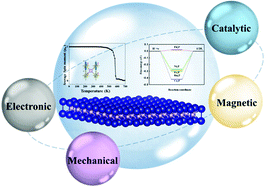2D tetragonal transition-metal phosphides: an ideal platform to screen metal shrouded crystals for multifunctional applications†
Abstract
Two-dimensional (2D) metal shrouded crystals, a new kind of conceptional material, have attracted remarkable attention due to their unique properties. Here, we propose a novel class of 2D metal shrouded materials, tetragonal transition-metal phosphides (TM2Ps), which show peculiar features of coexistence of in-plane TM–P covalent bonds and TM–TM interlayer metallic bonds. From a combination of high throughput searching and first-principles calculations, Fe2P, Co2P, Ni2P, Ru2P, and Pd2P monolayer sheets stand out because they simultaneously have high thermal, dynamical, and mechanical stability. All these five TM2P materials are metals, especially Pd2P, which can be a promising catalyst for the hydrogen evolution reaction with a very low overpotential. Moreover, these 2D TM2Ps show good ductility since they can withstand a tensile strain of up to 45%. Even in the large strain range, the strengthened interlayer TM–TM metallic bonds dominate the deformation behavior, and the corresponding metallicity of 2D TM2Ps is well preserved. Due to the competition between the d–d direct exchange and d–p–d superexchange interactions, Fe2P behaves as an antiferromagnetic material with a TN of 23 K, while Co2P is a ferromagnetic material with a TC of 580 K. Our results not only enrich the database of 2D metal shrouded crystals, but also provide novel 2D materials as promising candidates for multifunctional applications in nanoelectronics, spintronics and electrocatalysis.



 Please wait while we load your content...
Please wait while we load your content...